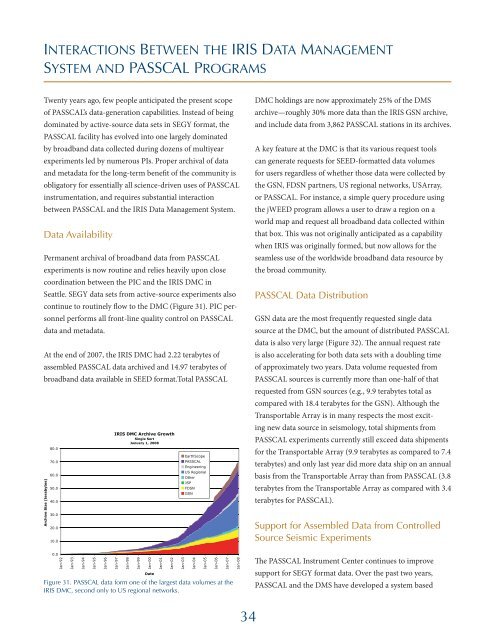Download 9.3 Mb pdf - IRIS
Download 9.3 Mb pdf - IRIS
Download 9.3 Mb pdf - IRIS
Create successful ePaper yourself
Turn your PDF publications into a flip-book with our unique Google optimized e-Paper software.
Interactions Between the <strong>IRIS</strong> Data Management<br />
System and PASSCAL Programs<br />
Twenty years ago, few people anticipated the present scope<br />
of PASSCAL’s data-generation capabilities. Instead of being<br />
dominated by active-source data sets in SEGY format, the<br />
PASSCAL facility has evolved into one largely dominated<br />
by broadband data collected during dozens of multiyear<br />
experiments led by numerous PIs. Proper archival of data<br />
and metadata for the long-term benefit of the community is<br />
obligatory for essentially all science-driven uses of PASSCAL<br />
instrumentation, and requires substantial interaction<br />
between PASSCAL and the <strong>IRIS</strong> Data Management System.<br />
Data Availability<br />
Permanent archival of broadband data from PASSCAL<br />
experiments is now routine and relies heavily upon close<br />
coordination between the PIC and the <strong>IRIS</strong> DMC in<br />
Seattle. SEGY data sets from active-source experiments also<br />
continue to routinely flow to the DMC (Figure 31). PIC personnel<br />
performs all front-line quality control on PASSCAL<br />
data and metadata.<br />
At the end of 2007, the <strong>IRIS</strong> DMC had 2.22 terabytes of<br />
assembled PASSCAL data archived and 14.97 terabytes of<br />
broadband data available in SEED format.Total PASSCAL<br />
Archive Size (terabytes)<br />
80.0<br />
70.0<br />
60.0<br />
50.0<br />
40.0<br />
30.0<br />
20.0<br />
10.0<br />
0.0<br />
Jan-92<br />
Jan-93<br />
Jan-94<br />
Jan-95<br />
Jan-96<br />
<strong>IRIS</strong> DMC Archive Growth<br />
Single Sort<br />
January 1, 2008<br />
Jan-97<br />
Jan-98<br />
Jan-99<br />
Figure 31. PASSCAL data form one of the largest data volumes at the<br />
<strong>IRIS</strong> DMC, second only to US regional networks.<br />
Jan-00<br />
Date<br />
Jan-01<br />
Jan-02<br />
Jan-03<br />
EarthScope<br />
PASSCAL<br />
Engineering<br />
US Regional<br />
Other<br />
JSP<br />
FDSN<br />
GSN<br />
Jan-04<br />
Jan-05<br />
Jan-06<br />
Jan-07<br />
Jan-08<br />
DMC holdings are now approximately 25% of the DMS<br />
archive—roughly 30% more data than the <strong>IRIS</strong> GSN archive,<br />
and include data from 3,862 PASSCAL stations in its archives.<br />
A key feature at the DMC is that its various request tools<br />
can generate requests for SEED-formatted data volumes<br />
for users regardless of whether those data were collected by<br />
the GSN, FDSN partners, US regional networks, USArray,<br />
or PASSCAL. For instance, a simple query procedure using<br />
the jWEED program allows a user to draw a region on a<br />
world map and request all broadband data collected within<br />
that box. This was not originally anticipated as a capability<br />
when <strong>IRIS</strong> was originally formed, but now allows for the<br />
seamless use of the worldwide broadband data resource by<br />
the broad community.<br />
PASSCAL Data Distribution<br />
GSN data are the most frequently requested single data<br />
source at the DMC, but the amount of distributed PASSCAL<br />
data is also very large (Figure 32). The annual request rate<br />
is also accelerating for both data sets with a doubling time<br />
of approximately two years. Data volume requested from<br />
PASSCAL sources is currently more than one-half of that<br />
requested from GSN sources (e.g., 9.9 terabytes total as<br />
compared with 18.4 terabytes for the GSN). Although the<br />
Transportable Array is in many respects the most exciting<br />
new data source in seismology, total shipments from<br />
PASSCAL experiments currently still exceed data shipments<br />
for the Transportable Array (9.9 terabytes as compared to 7.4<br />
terabytes) and only last year did more data ship on an annual<br />
basis from the Transportable Array than from PASSCAL (3.8<br />
terabytes from the Transportable Array as compared with 3.4<br />
terabytes for PASSCAL).<br />
Support for Assembled Data from Controlled<br />
Source Seismic Experiments<br />
The PASSCAL Instrument Center continues to improve<br />
support for SEGY format data. Over the past two years,<br />
PASSCAL and the DMS have developed a system based<br />
34

















